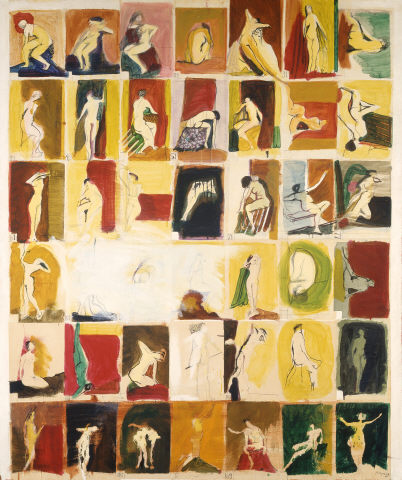
- Platex
- Collage and Oil
- Inv. 83P523
Rolando Sá Nogueira
L’Étude Académique II
A large-scale painting, presented for the first time in 1966 at the Rolando Sá Nogueira exhibition in Galeria 111, L’Étude Académique II (Academic Study II) is one of a series of works created after the artist had stayed in London as the holder of a scholarship awarded by the Calouste Gulbenkian Foundation. On his return to Lisbon in 1965, the influence of urban British culture made itself felt in the introduction of the collage as a technique that allowed signs and iconographies from diverse sources, from illustrations to postcards, to be handled quickly in the works that he was then creating. But, contrary to what occurred in the series of collages created in 1964 (High Life, or Natureza-Morta), in which the ripped graphic images, leftover canvas or glued papers are clearly visible and maintain a visual autonomy within the frame, in the series belonging to L’Étude Académique II the artist appears to have taken a step back: the collage of paper is relegated to a technical dimension that is virtually imperceptible, camouflaged under the manually applied colour and drawing.
The work shows 42 poses, with the nude live model aligning herself on the plane of the painting in a series of compartments in which the female figure is repeatedly treated with variations of line and tonality that individualise each image from a point of view that is specific to the figure and the scenes through which she is advancing.
However, the tonal and graphic variations, and the expressionist manner in which the colours are applied, prevent the overall image from being completely dominated by a regular order. In fact, the artist does not refrain from intentionally obliterating the compositional rule by diluting, under a white stain, the information contained in three of the compartments; the shapeless blot can then be interpreted as a metaphor for a moment of hesitation or a memory lapse which the artist fixes forever within the painting. The subjective stance is therefore reaffirmed against the idea of allowing artistic practice to yield to a discipline of mechanical observation and repetition that is exterior to the artist’s personal sensibility. The numbering of the drawings does not follow a regular progression. By tackling a historically traditional theme rooted in learning through observation of the visible in the face of eighteenth-century academicism, Sá Nogueira projects a distanced, ironic gaze on the task of painting or the (technical or social) constraints that haunt the artist. In a certain sense, therefore, L’Étude Académique II can be seen as a return to the moderate expressionist lyricism practised by Sá Nogueira prior to his London experience.
After experimenting with collages between 1964 and 1965, and possibly due to their having been poorly received by the public, the artist seems to have felt the need to modify his creative trajectory in line with a studied commitment to painting. However, this possible (not wholly desired?) commitment would not last long. From 1967 and particularly 1969 onwards, with the series Shunga and Erotropo, the artist would once again fully embrace his thirst for freedom in visual and iconographic conception. He would also revisit several themes that were close to his heart: eroticism, cultural criticism (O Marialva, c. 1971, or Misses, 1973), and jazz.
Ana Filipa Candeias
May 2010
| Type | Value | Unit | Section |
| Height | 180 | cm | |
| Width | 150 | cm |
| Type | date |
| Type | signature |
| Type | Acquisition |
| Sá Nogueira Retrospectiva |
| Lisboa, 1998 |
| ISBN:972-8137-91-5 |
| Catálogo de exposição |
| Sá Nogueira Retrospectiva |
| Museu do Chiado |
| Curator: Maria Jesús Ávila |
| 13 de Março de 1998 a 31 de Maio de 1998 Museu do Chiado |
| a |